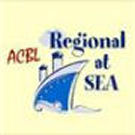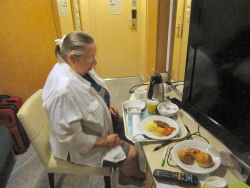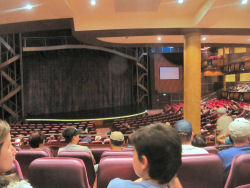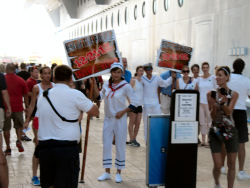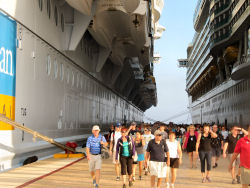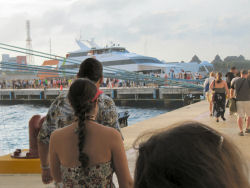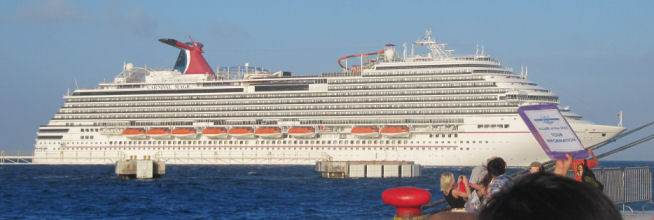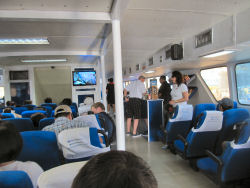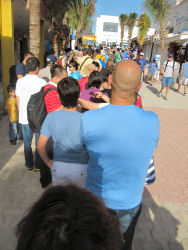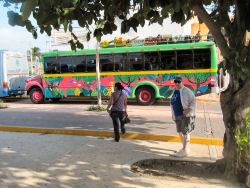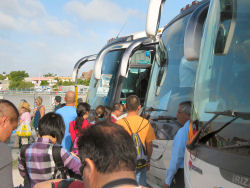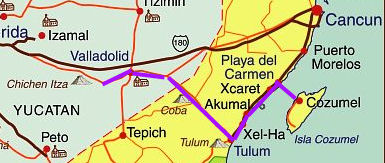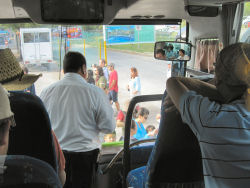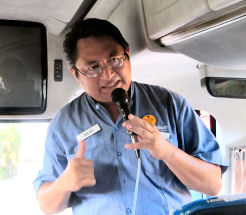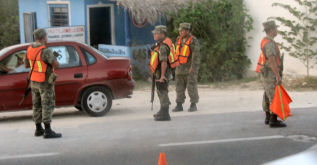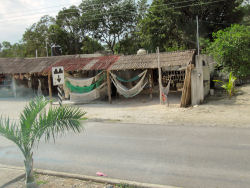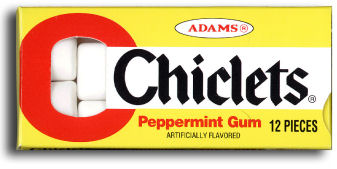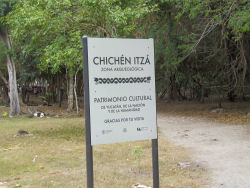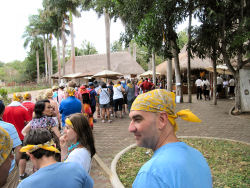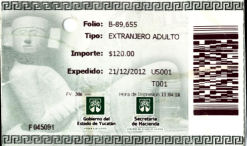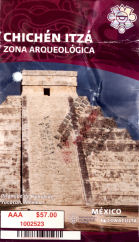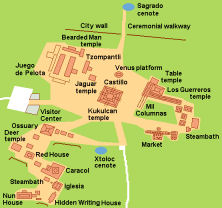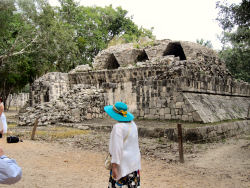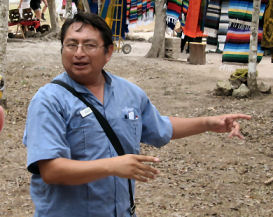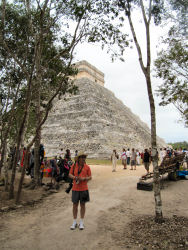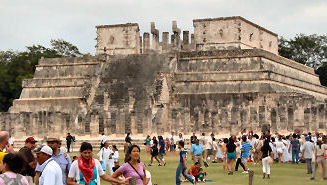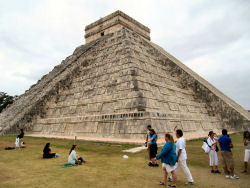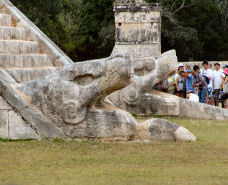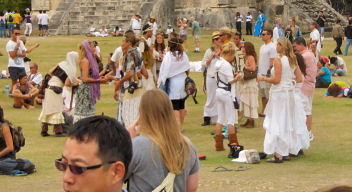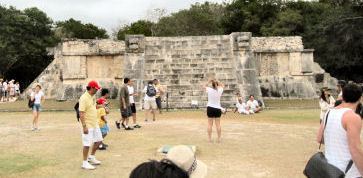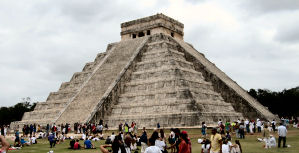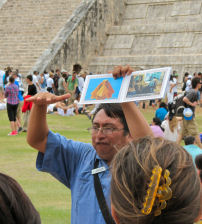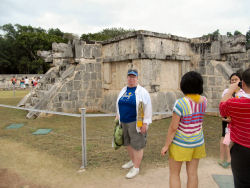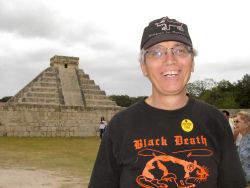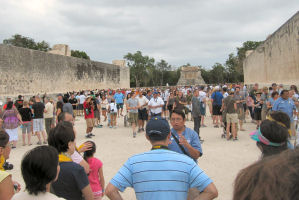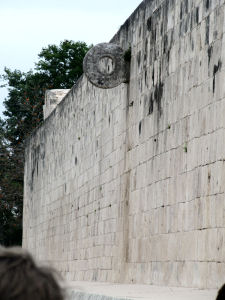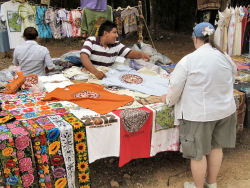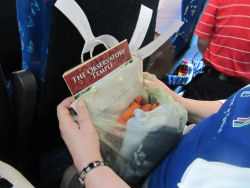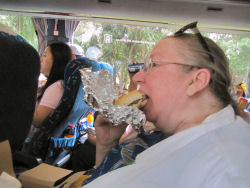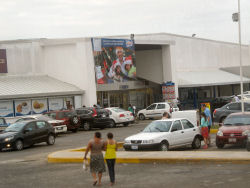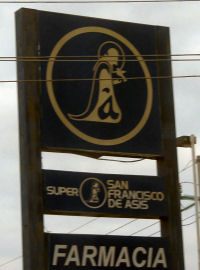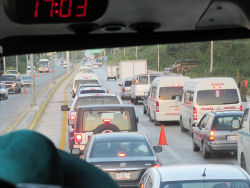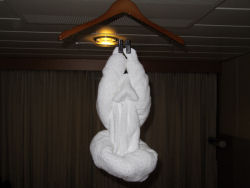We took Frank’s advice and ordered breakfast delivered to our stateroom.[1] This was definitely a good idea. The food seemed much better than in the dining room, and we definitely saved time.
At some point the ship docked in Cozumel, an island located a few miles off the coast of the Yucatán peninsula. Our objective was to visit the Mayan/Aztec ruins in Chichén Itzá, which was on the mainland, a few hours away by bus from the port city of Playa del Carmen. Our tickets for Chichén Itzá had been delivered to our stateroom on Thursday. We were to meet in the Amber theater at 7:30. The assembly was for the Chichén Itzá group and for two groups going to Tulum.[2] The Chichén Itzá people were given round blue stickers with the number 5 on them. We were told to affix the stickers to our shirts. A representative of Royal Caribbean, who said that he was from Haiti, addressed the group in English, Spanish, French, and some other language. He said, among other things, that the passengers bound for Chichén Itzá would leave first. We exited by the lower left door and walked down the stairs to the gangway on the second floor. Sue’s knees did not like the steps, but we were not afforded the opportunity of taking the elevator. Once on the dock we had to walk between the Allure and the Mariner of the Seas, which was moored on the other side of the dock. This was our first view of our gigantic vessel, which was only a little larger than the Mariner. The weather was a little cooler than I expected and rather windy. The passengers from the other ship wore the same stickers that we did. Scattered about on the deck were people dressed as sailors carrying signs that read “End of the World 12-21-12 Cozumel, Mexico.” Some people stopped to have their pictures taken with them. We proceeded to the end of our dock, made a left turn, and got in line for the ferry. The ferry was thrown about by the waves, and boarding was a little difficult. The seas seemed to settle a little once the ferry left Cozumel. The ferry ride lasted thirty-five minutes. A television set was on a loop that must have recycled at least five or six times. The most annoying part was when it played about twenty seconds from “The Lion Sleeps Tonight.” We left the ferry in Playa del Carmen and were met by — nobody. We walked up the street until we saw some men from a local travel agency with blue signs that advertised Chichén Itzá and Royal Caribbean. We were not certain whether we were in the right place. The only assuring fact was that the other people who were with us had blue stickers with #5 on them. At one point another local man told us to follow him. We walked quite a distance to our bus, which was #4 out of seven.Playa del Carmen seemed much livelier and more advanced than I recalled from when we were there decades. I remembered it as a rundown town that was full of skinny dogs and desperate inhabitants trying to sell silver-plated jewelry to the well-heeled tourists. It was still a Mexican city, but there were now quite a few restaurants and retail establishments that were obviously catering to people of means. In short, it had become a resort city.
Our guide identified himself as Julio. Our driver’s name was Marcellino. There were forty-eight tourists on the bus. Julio told us that his father was 100 percent Mayan. His mother was, he said, Spanish. He pushed up his sleeve to show us how light his skin was above the tan line.The bus was a traditional tour bus, but it was much nicer than the one that we had taken back in the nineties. Nevertheless, it was crowded enough to be uncomfortable. Each of us was provided with a yellow scarf, the purpose of which was never explained to us, and a round yellow sticker with the #4 on it.
Sue selected a seat by the window, and I sat next to her. There was not enough room to use my computer or even to stow my backpack under the seat in front of me. So, I had to keep it on my lap during the entire bus ride. My tendonitis acted up a few times, and I had to stretch my leg out in the aisle for a few seconds. Sue did not feel like going over the hands from our bridge game of the previous evening. So, we just took in the scenery and listened to Julio’s patter.Everyone was startled to see uniformed men with rifles on the side of the road. Julio said that we should not be alarmed. Guatemala and Belize, he explained, were just south of the Yucatán. The soldiers were looking for trucks that might be bearing drugs or migrants. His explanation was not too reassuring, at least not to me.
Julio spoke Mayan, Spanish, English, and Italian. He said that the Mayan language was very difficult. The pronunciation was especially difficult for tongues that were accustomed to European languages. It was rapidly disappearing, but an effort had recently been made to reverse this trend by teaching it in some of the schools in the Yucatán.I did not remember that the tour guides from our previous cruises had provided much historical or cultural information. I was pleasantly surprised by Julio’s thorough, entertaining, and enlightening presentation.
Julio explained that when the Spaniards arrived in the Yucatán they asked — in Spanish of course — the Mayans what this country was called. The latter replied in their own language “I do not understand what you are saying.” Julio said this phrase in Mayan. It did not sound much like “Yucatán” to me, but evidently that is what the Spaniards heard, and that is what they named the territory.At first I was surprised to learn that Playa del Carmen was the second largest city, after Cancún,[3] in the Mexican state of Quintana Roo. Then I remembered that our drive to Tulum featured nothing but jungle on both sides of the roasd. Julio’s home town of Mérida was in the Mexican state of Yucatán.
Julio told us how to pronounce Chichén Itzá. To my ears it sounded like CHEE chen eet ZAH. He said that anything close to that was fine, but he warned us not to call the site “Chicken Pizza.” The Itzá were a group of Mayans who came to the Yucatán from Guatemala.
The Mayans had written[4] a good number of books, but in 1562 all but three of them were ordered to be burned by Diego de Landa, the second Spanish bishop in the new world. The three extant books were in separate museums in Dresden, Paris, and Madrid.
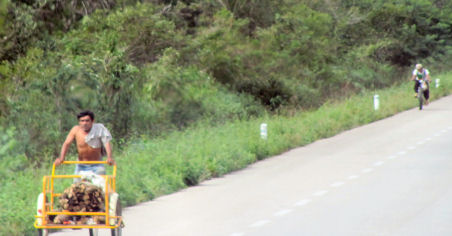
One by one the Mayan cities, which were the centers of civilizations much more advanced than those of medieval Europe, began to disappear in the eighth and ninth centuries. Julio suspected that the peasants, who were probably relegated to living a subsistence lifestyle outside of the city walls, rebelled and killed the nobles. Others have posited many other theories, including the speculation that the Mayans had been conquered.
Julio told us that we would see two major temples in Chichén Itzá. The large pyramid was the Temple of Kukulkan, the Mayan god who was roughly equivalent to the Aztec god, Quetzalcoatl, and the Temple of the Warriors, which had been built by the Aztecs. He explained that the Aztecs had at one point conquered the Mayas and thereafter used some of the Mayan structures for their own purposes. They also had constructed additional buildings.
The Mayans developed an interesting numbering system. A dot was used for units and a line for fives. Up to four of each could be used. For numbers above nineteen a dot was placed in the position above the regular numbers. The shell was used to designate 0. Arithmetic with these numerals was much easier than with Roman numerals.
The gum tree was for years the major source of revenue for the people of the Yucatán. The Adams Gum Company purchase much of it. In fact, the word “Chiclets” is derived from Mayan words.According to Julio the Mayans knew about nine planets.[5] The evidence for this conclusion was that nine celestial bodies were pictured in one of the books.
Julio spent the last ten minutes of the bus ride describing special customized souvenirs that he was selling. A book that explained Mayan culture, numbers, and history could be customized to any date. One page was printed on traditional tree bark. Sue and I purchased a few of these for $20 each. He also had some silver pendants for sale. It did not surprise me that the transactions had to be in cash.
After only a few minutes we passed a large sign indicating the entrance to Tulum. As the bus proceeded northwest toward Chichén Itzá several natives were visible propelled themselves along the side of the highway on bicycle carts. This was evidently a common form of transportation.
Julio admitted that he was a little worried that the crowd at Chichén Itzá might be very large. He feared that the traffic might therefore adversely affect our schedule.We did not arrive at the hotel Hacienda Chichén Itzá until almost 1:00.[6] Julio made it abundantly clear that everyone had to be back on the bus by 2:50. He had promised us a bathroom break when we reached the hotel, but we descended from the bus and immediately walked up to the site. We all just tightened our sphincters. I found it incredible that no one seemed to complain.
I expected a good deal of New Age activity in and around the site. Weeks earlier I had heard on overnight radio that tens of thousands of people who took the Mayan Prophecies seriously planned to be there for the big day. However, I saw very little evidence of any of the telltale signs of these people — crystals, invocations, incense, etc. Julio had told us that we would not be using the main entrance. Maybe there was more hubbub there.The walk from the bus to the archeological site was fairly lengthy. We then had to stand in line with a large number of tourists first to turn over the tickets that the ship had provided us and then to receive official tickets. Two different people handed us separate tickets. We then had to stand in a separate line at the end of which a third employee punched the tickets and allowed us to enter the site. The procedure reminded me of how they did things in Turkey.
Julio informed us that the area south of the pyramid was full of Mayan ruins. We did not have time to visit these at all. The area north of the pyramid was developed by the Aztecs.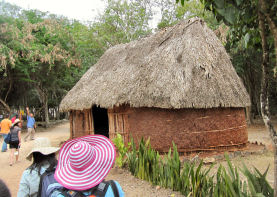
The view was reportedly even more interesting on the equinoxes. If the sun was out (and it usually was) a huge snake appeared to be crawling down the temple’s steps.
Julio told us that the pyramid, which was also known as El Castillo, had been designated as one of new seven wonders of the world. It had a total of 365 steps. Tourists have not been allowed to climb it since 2006.
After we saw the pyramid, Julio told us about the other temple, which was dedicated to the fallen warriors. We then walked over to what appeared to be a ball field between two high walls. Two large stone circles had been attached high up on the walls on either side. The glyphs on the walls appeared to indicate that two teams would attempt to put a ball through the circle. Julio explained that the players could not use their hands. The winners were apparently executed after the ball game.
After this explanation we had less than a half hour until we had to be back on the bus. Sue and I immediately started our descent toward the hotel’s parking lot. Along the way Sue stopped to peruse the wares on sale by the locals. The most unique of these was a whistle that somehow produced a noise that sounded like a jaguar’s growl. The last part of the walk bothered Sue’s knees quite a bit.
On the whole I was more than a little disappointed with Chichén Itzá. Some of our friends had raved about their visits to the site, but they all had visited the site before 2006, and they were allowed to climb the pyramid and go inside. I also expected a lot more activity with respect to the end of the Mayan calendar. Even the souvenirs were disappointing. The only thing that I hoped to purchase was a calendar for 2013, and no one seemed to be selling them. Maybe they were in the Visitor CenterJust as we arrived at the hotel two guys with British accents asked me about my Black Death tee shirt. When they figured out that it was about the bubonic plague in fourteenth century Europe, they were very impressed. They asked me to pose so they could photograph it from both the front and the back. I assume that they cut off my head. Marcellino provided us each with a lunch box from the bus’s luggage compartment. The box contained a cold hamburger, a hard-boiled egg, an apple, a pastry, a bottle of juice (mine was mango), and a bottle of water or a tiny can of coke. I took the water. The lunch was actually pretty good. The hamburger was actually better than the hot one that I had eaten in the ship’s dining room on Monday. All but two passengers returned to the bus on time. The stragglers did not board until 3:15. We were not, however, the last bus to leave the hotel. On the return trip I sat by the window and took a few photos through the window. The views of decrepit thatched huts accorded with my memory of this area from the nineties. The most surprising thing that I saw was a large drug store that appeared to be named Super San Francisco de Asis.
The clouds started to lift as we reached Playa del Carmen. We saw the sun for the first time in hours. However, we soon discovered that the winds had picked up considerably.
Sue and I planned to give Julio a tip of $10 and Marcellino $5. Sue got off first, and I got my stuff together. Somehow I lost the $5 bill. Fortunately one of the other passengers saw it on Sue’s seat and showed me where it was. Julio provided us with tickets for the ferry ride to Cozumel.The ferry was already very crowded when we boarded. We took the first seats that we saw, in the middle of the second row. A large number of people boarded the ferry after we did. The seas were rough, and, the attendants passed out plastic bags “just in case.” That we could not see out the windows made it a lot worse. A lot of people, including the people sitting behind and in front of us and the lady to my left, barfed. Sue and I kept our eyes shut and maintained our gastrointestinal equilibrium.
It seemed as if it took us hours to arrive back at Cozumel. By then it was quite dark and very windy on the dock. The wind was right in our faces. Some people were actually walking backwards. Everyone was moving at Sue’s pace, which was quite slow.We boarded at 7:45, more than an hour later than scheduled. When Sue and I opened the door to our stateroom we discovered an albino orangutan hanging from the ceiling.
Since I was planning to play bridge in the evening session at 8:00 I had no time for supper. I ate some cookies and then called Frank from the Conference Center. He arrived a couple of minutes later. Frank provided me with the handouts from the morning session. The topic was splinter bids.
Frank and I played in the side game. I messed up two hands, but we still scored 54 percent. Sue decided not to play. During the game many people noticed that the ship was rocking a little. It took some pretty rough seas to affect this behemoth.
Our most memorable round was against a math professor from Williams College in Massachusetts named Frank Morgan.[8] Of course, he knew about the actor named Frank Morgan who in 1939 played five roles in The Wizard of Oz. However, the bridge-playing mathematician Frank Morgan professed not to know that his namesake had a reputation as a heavy drinker. One participant in the film reported that when he played that soldier it was lucky that he had that guard box to stand in, or he would have fallen over.I returned to our stateroom after the game, and Sue and I took the elevator up to the fifth deck. We discovered that the Promenade Cafe had small sandwiches and peanut butter cookies available. We ate a small supper together there. Afterwards we decided to get a drink, and we went into two bars, both of which seemed smoky. We stayed only seconds.
I gave up, went back to the stateroom, and went bed. Sue, who loved to listen to almost any kind of live music, went to the Jazz Club. She reported to me later that she was present when a lady fell down in Bolero's, the Latin dance club.
[1] Frank ordered breakfast for the same time every morning. He had it timed so that he finished his shower a few minutes before it arrived. Once a young lady delivered it early. He thought that she would be embarrassed to bring it into the stateroom when he was clad in only a towel, but she was cool about it.
[2] Sue and I had visited Tulum on our cruises in the nineties.
[3] The name means “snake nest.”
[4] The Mayans wrote on paper made from tree bark.
[5] I was skeptical. Optics were not good enough to detect Pluto until the twentieth century. It seems much more likely to me that the Mayans knew of the five visible planets and four other bodies, perhaps moons.
[6] We stayed on ship time. It was noon local time, which might explain why the dancing was occurring.
